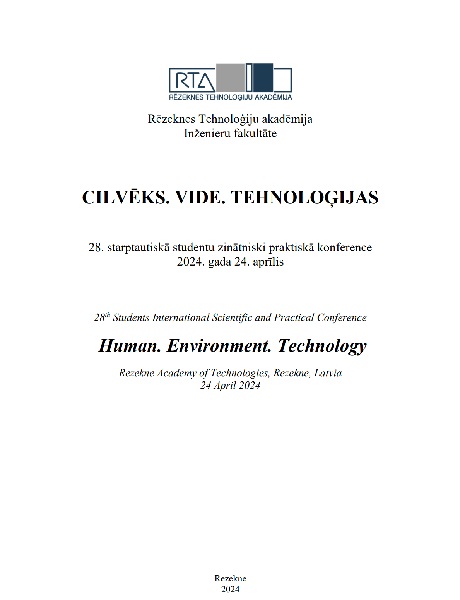INTEGRATION OF ELECTRONIC COMPONENTS IN THE DESIGN OF FUNCTIONAL CLOTHING
DOI:
https://doi.org/10.17770/het2024.28.8253Keywords:
electronic components, design, interdisciplinary project, textileAbstract
As technologies develop rapidly and continuously, they are also successfully incorporated into fashion, integrated into clothing, along with opportunities to improve the properties of textile fabrics. Impressive innovations are being created that can not only improve the quality of people's lives, but also show the creativity of designers in diverse clothing solutions, so it is necessary to study and analyse these possibilities and experiment with the implementation of achievements in a real environment. The perception of textiles has changed significantly to include electronic components, as a result today, smart textiles have been developed, that provide the user with increased functionality.
The purpose of the study is to identify the possibilities of integrating electronic components in the context of modern fashion design. The use of electronic components and examples from designer clothing collections are analysed, showing contemporary LED options and integrating them in the design project of the clothing collection.
In the course of the research, an experimental activity has been carried out in the research centre of Metalworking and Mechatronics (MM) of Rezekne Academy of Technologies. The purpose of the article is to evaluate the results of collaborative research of design and engineering students and their application in practice of design technology. Used research methods: theoretical – research, analysis of literature and Internet resources, empirical - experiment and its data processing. Participants of the research - students of engineering and design study programs, two lecturers, researchers. Study period 2022/2023. Project development is an extensive and complicated process, in order to fully develop a clothing model, it is necessary to make several prototypes until the best result is achieved. The research is of practical importance, as it substantiates cooperation in an interdisciplinary experimental process, its results and joint research activity.
Downloads
References
Par Izglītības attīstības pamatnostādnēm 2021.–2027. gadam [ On the Education Development Guidelines 2021-2027]. Available at: https://likumi.lv/ta/id/324332
Par Zinātnes, tehnoloģijas attīstības un inovācijas pamatnostādnēm 2021.–2027. gadam (likumi.lv) [On the Science, Technology Development and Innovation Guidelines 2021-2027 (likumi.lv)]. Available at: https://likumi.lv/ta/id/322468-par-zinatnes-tehnologijas-attistibas-un-inovacijas-pamatnostadnem-2021-2027-gadam
Latvijas dizaina stratēģija 2022-2027[Latvian design strategy 2022-2027] latvijas-dizaina-strategija-2022-2027.pdf (km.gov.lv)
Wang, L.; Fu, X.; He, J.; Shi, X.; Chen, T.; Chen, P.; Wang, B.; Peng, H. Application Challenges in Fiber and Textile Electronics. Adv. Mater. 2020, 32, 1901971. [Google Scholar] [CrossRef] [PubMed]
Mecnika, V.; Scheulen, K.; Anderson, C.F.; Hörr, M.; Breckenfelder, C. Joining Technologies for Electronic Textiles. In Electronic Textiles; Elsevier: Amsterdam, The Netherlands, 2015; pp. 133–153. ISBN 978-0-08-100201-8. [Google Scholar]
Valentine, L.; Ballie, J.; Bletcher, J.; Robertson, S.; Stevenson, F. Design Thinking for Textiles: Let’s Make It Meaningful. Design J. 2017, 20, S964–S976. [Google Scholar] [CrossRef]
Scataglini, S.; Andreoni, G.; Gallant, J. A Review of Smart Clothing in Military. In Proceedings of the 2015 Workshop on Wearable Systems and Applications—WearSys ’15, Florence, Italy, 18 May 2015; pp. 53–54. [Google Scholar]
Technology will influence fashion (2000). USA Today Magazine, Vol. 129 Issue 2666, 2-8. Database: EbscoHost
Burke, S., Sinclair, R. Computer-Aided Design (CAD) and Computer-Aided Manufacturing (CAM) of Apparel and other Textile Products. Materials, Design and Technology. Textiles and Fashion.Woodhead Publishing Series in Textiles 2015, Pages 671-703. Database: ScienceDirect
Lin C.H., & Lin, C.M. The Study in the Application of Nanotechnology Digital Printing in Clothing Pattern Design. Acessed on 22.10.2022. Available online: https://www.scientific.net/KEM.562-565.674
Joshi, M., Adak, B. Advances in Nanotechnology Based Functional, Smart and Intelligent Textiles: A Review. Reference Module in Materials Science and Materials Engineering. Comprehensive Nanoscience and Nanotechnology (Second Edition). Volume 5, 2019, Pages 253-290. Database: ScienceDirect
Hooijdonk, R. Wearing high-tech garments: smart clothes and nanotech fabric tailor the fashion of the future. Acessed on 18.09.2022. Available online: https://richardvanhooijdonk.com/blog/en/wearing-high-tech-garments-smart-clothes-and-nanotech-fabric-tailor-the-fashion-of-the-future/
Vassiliadis, S., Potirakis, S., Mitilineos, S., Stathopoulos, N. A., Rangoussi, M., Prekas, K. New Textile Materials and Structures: an Ignition for Changes in the Neighboring Fields of Engineering. International Conference on Technics, Technologies and Education ICTTE 2013 October 30-31 2013, Yambol, Bulgaria https://sites.google.com/a/trakia-uni.bg/ictte-2013/
Shak Sadi, Mohammad, Kumpikaitė, Eglė (2022) Advances in the Robustness of Wearable Electronic Textiles: Strategies, Stability, Washability and Perspective. Acessed on 28.11.24.) Available at: https://web.s.ebscohost.com/ehost/detail/detail?vid=0&sid=0ae2fe13-ad37-48ae-b929-1d520445045c%40redis&bdata=JnNpdGU9ZWhvc3QtbGl2ZQ%3d%3d#AN=157795416&db=a9h
Smart Textiles for Wearable Healthcare and Sustainability Explained. Available at: https://www.bioeng.ucla.edu/smart-textiles-for-wearable-healthcare-and-sustainability/
Krifa, M. Electrically Conductive Textile Materials—Application in Flexible Sensors and Antennas. (Acessed on 26.01.22.) Available online: https://www.mdpi.com/2673-7248/1/2/12/htm
Hexoskin (Carré Technologies Inc.) Hexoskin Smart Shirts—Cardiac, Respiratory, Sleep & Activity Metrics. Available online: https://www.hexoskin.com/ (accessed on 16 November 2024).
Simegnaw, A.A.; Malengier, B.; Rotich, G.; Tadesse, M.G.; Van Langenhove, L. Review on the Integration of Microelectronics for E-Textile. Materials 2021, 14, 5113. https://doi.org/10.3390/ma14175113
Fashion’s next Generation: How Technology and Culture are Combining. Available at: https://www.theinterline.com/2024/03/12/fashions-next-generation-how-technology-and-culture-are-combining/
Mārtinsone, K. Ievads pētniecībā: stratēģijas, dizaini, metodes. [Introduction to Research: Strategies, Designs, Methods]. Rīga: RAKA.,2011.


